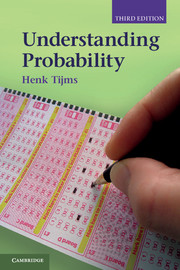Book contents
- Frontmatter
- Contents
- Preface
- Introduction
- PART ONE PROBABILITY IN ACTION
- PART TWO ESSENTIALS OF PROBABILITY
- 7 Foundations of probability theory
- 8 Conditional probability and Bayes
- 9 Basic rules for discrete random variables
- 10 Continuous random variables
- 11 Jointly distributed random variables
- 12 Multivariate normal distribution
- 13 Conditioning by random variables
- 14 Generating functions
- 15 Discrete-time Markov chains
- 16 Continuous-time Markov chains
- Appendix: Counting methods and ex
- Recommended reading
- Answers to odd-numbered problems
- Bibliography
- Index
9 - Basic rules for discrete random variables
Published online by Cambridge University Press: 05 August 2012
- Frontmatter
- Contents
- Preface
- Introduction
- PART ONE PROBABILITY IN ACTION
- PART TWO ESSENTIALS OF PROBABILITY
- 7 Foundations of probability theory
- 8 Conditional probability and Bayes
- 9 Basic rules for discrete random variables
- 10 Continuous random variables
- 11 Jointly distributed random variables
- 12 Multivariate normal distribution
- 13 Conditioning by random variables
- 14 Generating functions
- 15 Discrete-time Markov chains
- 16 Continuous-time Markov chains
- Appendix: Counting methods and ex
- Recommended reading
- Answers to odd-numbered problems
- Bibliography
- Index
Summary
In performing a chance experiment, one is often not interested in the particular outcome that occurs but in a specific numerical value associated with that outcome. Any function that assigns a real number to each outcome in the sample space of the experiment is called a random variable. Intuitively, a random variable can be thought of as a quantity whose value is not fixed. The value of a random variable is determined by the outcome of the experiment and consequently probabilities can be assigned to the possible values of the random variable.
The purpose of this chapter is to familiarize the reader with a number of basic rules for calculating characteristics of random variables such as the expected value and the variance. In addition, we give rules for the expected value and the variance of a sum of random variables, including the square-root rule. The rules for random variables are easiest explained and understood in the context of discrete random variables. These random variables can take on only a finite or countably infinite number of values (the so-called continuous random variables that can take on a continuum of values are treated in the next chapter). To conclude this chapter, we discuss the most important discrete random variables such the binomial, the Poisson and the hypergeometric random variables.
- Type
- Chapter
- Information
- Understanding Probability , pp. 283 - 317Publisher: Cambridge University PressPrint publication year: 2012



